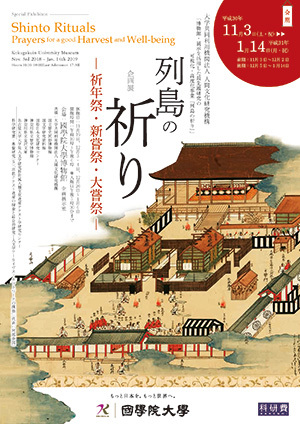Today throughout the Japanese archipelago, rites and rituals are held for the Kami (Shinto Deities) and Buddhism Deities. People present food and offerings, praying that they will prevent disasters, ensure rich harvests, and bring happiness in daily life.
This is thought to have begun around the third or fourth century. Starting in the fifth century, the rites that had been carried out in a variety of ways throughout the archipelago began to be standardized from the Tohoku area to Kyushu. From the end of the seventh century onwards, these rites were put into law with the Jingi-ryo (Kami Laws, The ritual code of Jingi-kan). Many of these laws were related to rice cultivation, which was an important state industry in ancient Japan. To pray for a bountiful harvest was to pray for peace and stability in daily life.
The Engi-shiki, documents of laws and regulations in the tenth century, includes detailed passages on state-run rites, just like the Jingi-ryo. These include the Hirose Ōimi no Matsuri (a festival held at Hirose Shrine for the food Kami) and Kazakami no Matsuri (a ritual held at Tatsuta Shine for the wind Kami) in the fourth and seventh month of the year, and the Niiname-sai (New Food Festival) in the eleventh month. From the Engi-shiki we can see that people, praying to the kami for bountiful harvests and peace in the country, held various festivals, as well as get a glimpse of the items and Norito (ritual prayers festivals. Such rites cycles took place at shrines around Japan.
Also, when a new emperor assumed the throne, the Daijo-sai (Great New Food Festival) would be held in the eleventh month. The emperor himself would offer food to the kami.
In this exhibition we will introduce the rice harvest cycle and its relationship to state rites, focusing on the Kinen-sai (a festival of prayers for a good harvest and well-being), Niiname-sai and Daijo-sai.
*Flyer
Outline
| Term | Nov. 3, 2018 (Sat) - Jan. 14, 2019 (Mon) |
|---|---|
| Place | Kokugakuin University Museum, Special Exhibition Space |
| Hours | 10:00 – 18:00 (Last admission 17:30) |
| Closed | Nov. 19 Dec. 3 - 4 Dec. 26 - Jan. 6 |
| Admission Fee | Free |
| Access | Accessible on foot or by bus, 10-15 minutes from Shibuya, Omote-sandō, or Ebisu Station. Directions to Kokugakuin University Museum |










